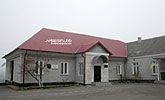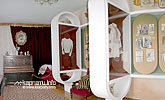Memorial Museum
of Solomia Krushelnytska
The museum complex consists of St. Nicholas church (1625); three kossacks' crosses around the house; the stone 'Freedom' cross (1848), two statues of biblical figures and a white marble tombstone on the grave of Solomia's parents in a rural cemetery, brought by the singer from Italy.
One more three-room section was opened 18 May, 1986, which became possible, to the great extent, due to the efforts of the museum staff and V. Lavreniuk, the director of ethnographic museum. The designers of that exposition were V. Pozniakov, Y. Bodnar and L. Prokofieva. All in all, you can see in the exposition wide range of personal possessions of S. Krushelnytska and her family.
The name of Solomia Krushelnytska became a matter of national pride in Ukraine. The singer's repertoire included more than 60 opera classical parts, and she was an unsurpassed interpreter of Ukrainian folk songs. Famous composers, conductors, singers, musicians, writers, artists, including G. Puccini, R. Leoncavallo, A. Toscanini, L. Mignone, E. Duse and many others were in favour of her great talent.
'The most beautiful and charming Butterfly' — was the inscription that G. Puccini made on his photo portrait he presented to Krushelnytska in gratitude for his rescure after the previous big failure at the famous La Scala theatre of his opera 'Madama Butterfly'.
Solomia Krushelnytska is revered all over the world. Her opera works are the part of the world cultural heritage and her voice was heard by the listenets in Europe, South and North Americas and Egypt. She's well-known and honored in her native land and in Ternopil region in particular. 2012, the year of the singer's 140th anniversary, became the year of Solomia Krushelnytska in Ternopil.
Children — 3 UAH.
Bila village
S. Krushelnytska St., 47-a
Tel.: +38 (097) 224-18-95
+38 (0352) 29-91-36 (school)
Go by bus from Ternopil to Bila village. The museum is located in the local school.
By car
Go along Brodivska street from Ternopil to Bila village. In the villge turn left near the bus station, go until the cemetery and turn left, then go straight on untill you see the school building (left of the road).

 Ukraine
Ukraine Poland
Poland Slovakia
Slovakia
 Українською
Українською












